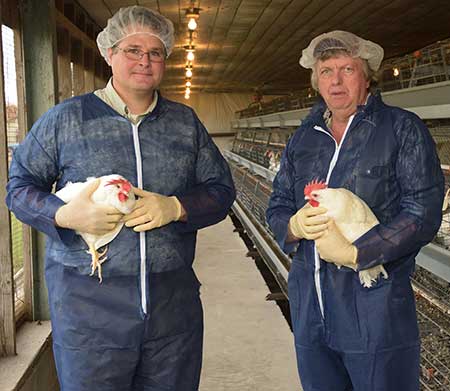News
The information presented on this page may be outdated. It may refer to situations which have changed or people who are no longer affiliated with the university. It is archived as part of Mississippi State University's history.
Parchman fowl unite MSU, state agencies

A chicken flock at the state's largest correctional facility is uniting the Mississippi State University, Mississippi Department of Health and Mississippi Department of Corrections.
2/27/2015
By: Linda M. Breazeale
Jeffrey Brown, state medical entomologist with the Mississippi Department of Health, visited the Mississippi State Penitentiary, also known as Parchman Farm, to address a growing fly and mosquito problem. He observed the flight patterns of the flies and determined they were originating from the facility's egg-producing poultry houses.
He could also see that he needed to call in reinforcements.
"My first thought was to call Mississippi-based Cal-Maine Foods, the nation's largest egg company, and they referred me to the poultry experts at MSU," Brown said. "The best part was that everyone at the facility—from the superintendent to the supervisors&mdsah;wanted to make the necessary improvements. Even the inmates bought into the program and are taking their responsibilities seriously."
The facility's 35,000 hens furnish eggs for the state's 11,500 inmates held at three major prison facilities, four restitution centers and 17 community work centers. The poultry houses, which were originally designed for hogs, produced the ideal environment for pest populations to explode, Brown added.
"Of course, there was not a lot of money available to make improvements, but many of the changes did not cost extra," he said. "Three incredible improvements you can't miss are the reduced odor, the sound of happy chickens and the smiles on the faces of those working in the poultry houses."
MSU Extension poultry specialists Tom Tabler and Morgan Farnell agreed the challenges seen on their first visit could have easily overwhelmed the Parchman workers. Last fall, they made their third visit and continued to be impressed with the improvements in the houses.
"We knew the facility would need more workers than they were using," Tabler said. "The initial recommendations targeted the environmental conditions, such as improved drainage to reduce the smell and fly problems. Those changes would improve conditions for the chickens and the workers, allowing each to be more productive."
The Extension specialists worked with the Mississippi Board of Animal Health and have collected data on several aspects of the houses -- water, birds, eggs, light, feed and waste management practices.
"To their credit, they have made a lot of changes in nine months," Tabler said. "They are not in the chicken business; they are in the people business, and the chickens are the beneficiaries of several people from various organizations working together to solve a problem. We want to help with the human aspect as well as taking care of the birds."
Still, their recommendations for the Department of Corrections are no different than they would be for anyone else in the poultry business.
"Just like with commercial growers, we want to share options that could improve productivity," Tabler said. "Most of the time, producers will make the right choices if given enough information. Often, we can ask the right questions to help them determine their best path."
Stanley Brooks, director of agricultural enterprises at Parchman, said the chicken houses were established in the mid-1990s to cut egg costs and help teach inmates skills and work ethics. By last fall, he had expanded the program's workforce from a few inmates to almost 40 men. Every day, they must check feed and water, clean floors and gather eggs.
"We are steadily working to improve the poultry program," Brooks said.
Farnell, who is also a researcher with the Mississippi Agricultural and Forestry Experiment Station, said preparing for winter and improving the birds' nutrition are among the improvements planned at the Parchman poultry operation.
"Our first visit was in early 2014, and it was brutally cold," Farnell said. "They had problems with pipes freezing, and that limited their ability to keep the houses clean. They know more work will need to be done to seal the barns against cold winds. We are constantly asking what we can do to help.
"The diet formulation has not been updated in 10 or 20 years," he added. "While the nutrient profiles of corn and soybean meal have not changed drastically, bird genetics have, which means their nutritional needs have changed, too."
"A lot will depend on the (Parchman) farm's plans to continue with corn- and soybean-meal-based diets or switch to milo and soybean," said Kelley Wamsley, an MSU poultry nutrition specialist and MAFES researcher who also has visited the facility. "The diet formulation will be changed as they get in new birds and will be based on the season and the breed, strain and age of the birds. The goal of the new formulation is to provide the birds with the necessary nutrients, as well as being cost effective and helping the birds produce more eggs."
Earnest Lee, superintendent of the Mississippi State Prison, said the site visits have been helpful in getting the poultry program back on track.
"We are anxious to follow recommendations by Dr. Farnell and the rest of the team," Lee said.
View More News